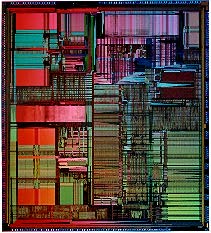March 27, 2006Microsoft Brownie MixThe Harvard and MIT experts are wrong. Everybody is linking to the NYT article that blames Microsoft's woes on too many lines of code in support of backward-compatibility. Lohr and Markoff quote HBS prof David Yoffie: "Windows is now so big and onerous because of the size of its code base." And Sloan's Michael A. Cusumano: "Windows is too big and too complex." While it may be true that the Windows codebase is too complex, Microsoft is the one company that knows how to do big code. Cracking the mythical man-month is an elusive black art that is real and practiced in Redmond. Brooks notwithstanding, huge teams and massive programs are problems Microsoft can solve; they are not the cause of the problem. I do have a thought for the business school folks about what ails Microsoft, though. It has to do with Procter and Gamble and brownie mix at saturation.... The Product is a Picture
The overcomplexity of Windows is not the problem. The overcomplexity is a picture of the problem. If Vista lacks simplicity, it is because the team lacks focus. It is On Purpose Yet Microsoft execs would explain, when being candid, that the complexity comes consciously. Yes, they might admit, the fat product design comes from the fat org structure, but the fat org structure was put in place on purpose. It comes from the Big Strategy of Bundling - or as we're now calling it - "Integrated Innovation." The execs would point out that their Big Antitrust-Baiting Strategy is Daring, that it is Pushing-The-Limits. That is true. Bundling on such a massive scale is daring - it skirts danger by calling government regulators on their antitrust bluff - and it does push the limits of software engineering. But I still think it is the wrong strategy and I still think they are missing something. Brownie Mix History I heard a story while at Microsoft that may or may not be true. But it is a good business school story so here it is. After graduating from Harvard but before dropping out of Stanford Business School to help Bill start Microsoft, Steve Ballmer worked at Procter and Gamble where he was the assistant product manager for Duncan Hines Brownie Mix. At the time, mix was sold in narrow boxes with the pretty product name splashed across every side of the box. Steve noticed that corner grocery stores liked to stock his leading-brand mixes next to competitive brands. Grocers would line up the brownie mix choices side-to-side like books in a library. And shoppers could easily see the variety and pick what they wanted. Usually shoppers picked the leading brand, but they might sample a less well-known competitor once in a while. But for the market leader, choice is a problem. Even if your product is vastly superior, you can lose a whole chunk of brownie mix market share based on the fact that consumers have only pennies to lose by sampling your neighbor. In Brownies, Shelf Space is Everything The solution is classical marketing. Swim upstream. Require the store owners, who have more than pennies on the line, to make the choice instead. So Steve (the apocryphal story goes) did a very simple thing: he changed the brownie mix packaging so that the narrow side couldn't be pointed outward. Maybe he printed the ingredient list on that side, I don't know. From a customer's piont of view it doesn't make much of a difference one way or the other. But for the little corner grocer, it has ramifications. If you have 6 inches of shelf space for mixes, you see, you can fit several nice rows of narrow 2-inch boxes side-by-side, one for each competitive brand. But if the leading brand has to be placed sideways in a 6-inch-wide package? Well then you only have room for one brand. The storeowner has to choose. So by the time the shopper comes into the store, the choice has already been made. That's why sitting on the shelf, facing outward all by itself, is your one and only choice - the leading brand.  Shelf Space for Word Processors In the software biz, some people say "programmers only write one program in their whole life." What that means is programmers like to write the same sort of code over and over, just changing the specific details. It is like writers who write the same story and bands who sing the same song over and over. I have worked on VOIP, developer tools, browsers, and oscilloscopes. But to be perfectly honest I can tell you that I am a "compiler" programmer at heart and despite my efforts to diversify my vocabulary, all my programs sort of have that flavor. I think it is also true in marketing. Marketers like to run the same campaign over and over. And it seems that Ballmer's favorite kind of marketing is shelf-space marketing - the brownie mix box trick. In software, shelf-space marketing is done by bundling. For example, you eliminate the market for independently packaged productivity application software by putting the four major app categories in a big box all together. Microsoft Office was a real winner, wasn't it? Let's play that game again. The Allchin Tax
They explain to me that bulking up Windows is done on purpose, because it is a shelf-space and bundling strategy. The job of shoving every technology into Windows is sometimes called the "Allchin Tax" because he has been the biggest advocate of the bulk-up-Windows strategy. For years, Jim Allchin has been working mightily to replicate Chris Peters's master stroke of unifying Office back in the early 90's. The reorgs that slam together SQL and MSN and Windows and so on are done for a reason. They are done because Microsoft believes that Windows has got to include so much good stuff that the shopkeepers - ahem - the OEMs - have no reason - and no shelf space - to provide anything else. You can't leave room for Flash-Java-Adobe-Google neighbors. You have to put the product in a wide box that sits sideways on the shelf, leaving no extra space. Brownie Mix at Saturation But imagine, if you will, your brownie mix brand already has 95% market share. What do you gain by expanding the package from 6 to 12 inches? 24 inches? You will have to start to convince the world to change their diet so all they eat is brownies. Chocolate, Vanilla, Cheese-flavored Antivirus brownies. Consumer brownies, Enterprise brownies, Advanced Server brownies. What happens when you increase the box to 48 inches? To succeed at selling brownies in a big 48-inch Vista-sized box, you have to suck all the oxygen out of the whole idea of a grocery store in the first place. Eventually, your huge display-case brownies are so difficult to stock, and grocers have so little wiggle room, that you end up driving the poor shopkeepers out of business. That's what happens with brownie mix at market saturation. Grocery stores selling nothing but huge crates of brownie mix is a bizarre image. As usual I have pushed the analogy way too far. But I think there is some truth to it. How are your DELL and GTW shares doing lately? Think about it. Microsoft should Solve Problems, not Packaging So I want to return to my orignal assertion, that the problem is fundamentally cultural. Somehow, Microsoft has forgotten the fact that it is a company about making home computers possible. Instead it has fooled itself into thinking that it is a brownie mix business, i.e., a market-share-driven, bottom-line-driven, shelf-space-driven business. I believe that if instead you stick with the mission of home computers, you can do something far greater. Because the engineering problem leads you to something more profound than bigger boxes of brownie mix. In the food industry, the engineering problem leads you to neat ideas like microwave fast food, precooked sausages, and ways to distribute little boxes of milk without using refrigeration. In the personal computer business, the engineering problems will lead you to products like configuration-free computers, portable hard drive music players, and ways to distribute media on the Internet without piracy. In other words, if you tackle the consumer problems and stick to your mission, you will end up where Apple is today: you define whole new markets rather than fighting for share. Engineering in the service of increasing shelf space is just packaging - even if it is massive, major engineering. But if your new products reach new customers - even if the engineering is minor - that is innovation.
Saturation is Nothing to Fear In the technology business, market saturation is nothing to fear. True, it may not be possible to bundle your way to growth once you enjoy complete domination of a market. But winning share through packaging is only part of the process. It is not the imperative that should drive the whole business. The technology business is about sticking to your guns and keeping your eye on the real problems that need to be solved. When you do this, you will discover new markets. You will profit. You will change the world. There is greatness in innovation. It just doesn't look like Vista. Posted by David at March 27, 2006 08:15 PMComments
I originally couldn't remember the details of the parable about packaged goods until I realized that the cake brand owned by Procter and Gamble in the 70's was Duncan Hines. I've rewritten the story with the right brand-names in place. http://www.askmen.com/men/business_politics_60/68c_steve_ballmer.html Posted by: David at March 27, 2006 08:20 PMI think you have hit the nail on the head. This reminds me of the whole "developer mindshare" thing from the late '90s. I've seen this in other industries, too - a focus on crowding out competitors as part of an overall market strategy. Although never to this degree. I've added my thoughts over on my blog. http://inactivity.blogspot.com/2006/03/cupcakes-at-saturation.html Posted by: Mike C at March 27, 2006 08:20 PMHello David, Nice article, but I have to differ with you about Hi Divakar, it's been a long time! I happen to really like those new gourmet precooked sausages that they sell. You know, the ones with chicken and apple flavor? Heh. Cheers. Posted by: David at April 5, 2006 07:00 PMHello David, You must try the English breakfast when in Britain, if you haven't already. Now that is a neat idea, as long as it isn't repeated too often. Posted by: divakar at April 6, 2006 11:46 AMPost a comment
| |
| Copyright 2006 © David Bau. All Rights Reserved. |


